| Release List | Reviews | Price Search | Shop | Newsletter | Forum | DVD Giveaways | Blu-Ray/ HD DVD | Advertise |
| Reviews & Columns |
|
Reviews DVD TV on DVD Blu-ray International DVDs Theatrical Reviews by Studio Video Games Features Collector Series DVDs Easter Egg Database Interviews DVD Talk TV DVD Talk Radio Feature Articles Columns Anime Talk DVD Savant HD Talk Horror DVDs Silent DVD
|
DVD Talk Forum |
|
|
| Resources |
|
DVD Price Search Customer Service #'s RCE Info Links |
|
Columns
|
 |
Ikarie XB 1 |

|
Ikarie XB 1 Filmexport Home Video -- Region 0 PAL 1963 / B&W / 2:35 anamorphic 16:9 / 83 (PAL speed?), 90, 78 min. / February 20, 2006 / $? Starring Radovan Lukavský, Zdenek Stepánek, Frantisek Smolík, Otto Lackovic Cinematography Jan Kalis, Sasa Rasilov Production Designer Jan Zázvorka Special Effects Jan Kalis Film Editor Josef Dobrichovský Original Music Zdenek Liska Written by Jindrich Polák and Pavel Jurácek Produced by Filmové Studio Barrandov Directed by Jindrich Polák Reviewed by Glenn Erickson |
One of the more delightful fringe benefits of the DVD revolution is the growing availability of Eastern-bloc movies made roughly between 1946 and 1990. The Cold War gave Western governments and film distributors the opportunity to block the wide release of over four decades' worth of films from Eastern Europe. The few movies from East Germany and the Soviet Union that did receive respectable releases here tended to be exceptional art-house fare such as The Cranes are Flying or War and Peace.

Some Eastern-bloc genre fantasy imports were re-titled, re-dubbed and re-edited to remove anything even vaguely resembling the dreaded propaganda that the Soviets were supposedly churning out to seduce the world into following Karl Marx. The American distributors did their best to make the films look American in origin. Savant saw an animated fairy tale called The Snow Queen to which a prologue with Art Linkletter had been added. Many 50s and 60s kids came into contact with pictures like The Magic Voyage of Sinbad without knowing they were made in Moscow. If critics found out, as happened with the release of the epic fantasy Illya Muromets (aka The Sword and the Dragon) their reviews discussed the propaganda angle first and derided the movie second.
1Science fiction was one of the easiest genres to sell in the West. The few Soviet space-themed films tended to be weighed down with socialist sentiments, and some of them were pointedly anti-American. The Russian Nebo zovyot was about competing space programs. The conniving, backbiting astronauts on one side get themselves marooned on a planetoid. The cooperative, freedom-loving and benevolent astronauts from the other side have to rescue them. It's made very clear which side represents the Soviet Union! The East German Der schweigende stern shows us a planet Venus destroyed by its own aggressive nuclear weapons program, a fate pondered by an international crew of spacemen. Only one American is on board, and he's there only because he was brave enough to ignore his government's orders not to cooperate with an Eastern-bloc rocket program. Among the Soviet-influenced films Savant has seen, only the thoroughly juvenile space adventure Planeta bur seems devoid of outright political content.
In 1964 American-International released an odd space movie in B&W called Voyage to the End of the Universe. Savant caught it on a kiddie double-bill with Godzilla vs. The Thing and was enchanted by its spaceship, which resembled a cross between a flying saucer and an upside-down Hostess Twinkie. The movie had a serious tone and some scary situations. In the 1970s we heard that the original was called Ikarie XB 1, but rumors were full of misinformation: The picture was Russian, it was two hours long, it was in color, etc.
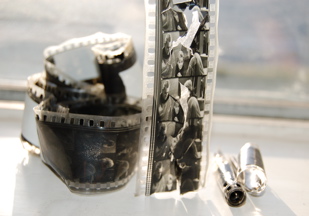
Savant spent years hoping to see the movie again. In 1976 he organized a Science Fiction retrospective at UCLA and rented A.I.P.'s 35mm library print (cost to the Associated Student's Union = $75). It was basically intact but still a frustrating experience. By that time we knew the film was originally Czechoslovakian and had figured out for ourselves that its funky-looking final shot was probably an American editorial alteration.
In 2001, Savant arranged to borrow MGM's last existing A.I.P. 35mm print of Voyage to the End of the Universe, which had been in Orion's possession before entering the bottomless vaults at Metro. A studio restorer who had accumulated some free projection time at a local lab held a screening for a few of our friends. The print was probably the exact same one Savant screened in 1976. It had since been ruined by moisture. Each reel played well enough until the last couple of hundred feet, at which point the film started to turn brittle. Since the print wasn't salvageable, the projectionist just kept rolling until the film buckled and snapped. The last fifty feet of each reel was a mass of celluloid that wouldn't peel off the rusted reels; we threw that away and rewound what was left onto cores. I saved some scraps as souvenirs.
The happy ending to this story occurred at the American Cinematheque at the Egyptian Theater in Hollywood, which had previously showcased 35mm touring prints of many fascinating Eastern European classics, including fairy tales by the Russian Aleksandr Ptushko and the Jules Verne adventures of the Czech Karel Zeman. In August of 2004 Savant attended a double bill of End of August at the Hotel Ozone and the original Ikarie XB 1... in the Czech language, full length, 35mm. I posted an enthusiastic first-impression mini-review at DVD Savant the morning after (August 19, 2004). Of course, my main aim was to beg the DVD gods for a disc release.
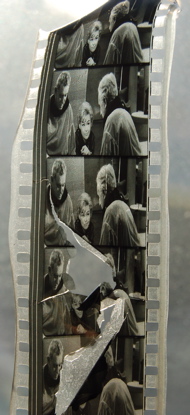
Cut to late 2005. Facets video is in the midst of a series of DVD releases of older films from Czechoslovakia and Hungary, "Big Cult Name / Modest Commercial Yield" titles that include End of August At the Hotel Ozone, but no Ikarie XB 1. Savant knows that a possible factor in the non-appearance of the space movie might be related to the earlier A.I.P. release. An MGM legal person once told me that American rights for the film had expired long ago when A.I.P. was still intact. But could the first Voyage to the End of the Universe import still block a second?
3
In January of 2006 a couple of readers (Thomas Treasure, for one) contacted me with news of an impending R2 Czech release of Ikarie XB 1. Then Savant received this terrific Email on February 20. It's self-explanatory:
Hello Glenn. I am a regular reader of your DVD Savant pages, so I know you are fond of the Ikarie XB-1. Perhaps it would interest you to know that Ikarie is finally available on DVD here in Prague starting from today.
It looks like a fine edition with English subtitles and in correct aspect ratio.
If you are interested in this edition and don't already have a "Czech connection"
I would be very happy to send you a retail copy.
Kind regards, Marek -----
Well, you can guess how I responded to that offer. The disc arrived a week later.
The ship then pauses to investigate a derelict spacecraft. Two astronauts are sent to enter the dead ship. Ikarie's files indicate that it is a military craft from 1987 called the Tornado. Scores of corpses are inside, including gamblers still holding their cards and two officers who apparently killed each other with ray guns. The spacemen theorize that the officers gassed the other passengers to conserve a dwindling oxygen supply, and then fought between themselves. One of the investigators accidentally trips a mechanism, and before they can leave, Tornado self-destructs with an atomic bomb.
The ship continues on its voyage. It comes within range of strange radiation from a Dark Star, which has adverse effects on the crew. Svensen and Michael (Jirí Vrstála and Otto Lackovic) receive heavy exposure while on an EVA to install a new power module. They break out in ugly burns, and Michael becomes deranged and threatens to destroy the ship. The Engineer talks Michael into surrendering peacefully, just as the Dark Star's radiation makes the rest of the crew somnambulistic. The Captain (Zdenek Stepánek) talks the engineer out of aborting the mission as both fall asleep.
The crew reawakens less than a day later, and the Science Officer discovers that the Ikarie has been shielded from the Dark Star by a force field projected from The White Planet: An intelligent civilization has reached out to protect the voyagers. The crew of Ikarie, including the newborn baby, watches their viewscreen to see what miracles await them on the welcoming new world. As the clouds part, they're greeted with a view of an endless city of light.
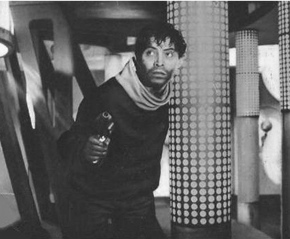
Ikarie XB 1 was a hit at the 1963 Trieste Science Fiction Film Festival, where it played with other entries like Italy's Omicron, the Soviet Union's The Amphibian Man and Roger Corman's X (The Man with the X-Ray Eyes). In 1963, the only space films with more elaborate special effects were Forbidden Planet, This Island Earth and the Toho pictures Battle in Outer Space and Gorath. The exterior design of the Ikarie is unusual, with three saucer-like detachable engines. It appears to fly on wires, an illusion done better by the Japanese. But the impressive spaceship interior has angular, hexagonal corridors that appear to have influenced Stanley Kubrick's 2001: A Space Odyssey a couple of years later. Kubrick's modular environments appear to be cast in plastic or fiberglass. A close inspection of the Czech ship interior on the big screen reveals a lot of woodwork covered by contact paper!
The whole film was shot on a single big set except for one airshaft scene filmed in a 200-meter TV transmission tower near Prague. The main bridge is a large hall dominated by an electronic view-screen. The open space doesn't seem as wasteful as the cavernous interior of ship in Planet of the Vampires. Deck chairs have diagonal back braces somewhat like the furniture on the bridge of Exeter's ship in This Island Earth. There are also large sets representing a dining hall-rec center (with a carousel food dispenser), a gymnasium and a bathhouse. The idea of a thriving space community will remind viewers of the later Star Trek: The Next Generation TV series. Crewmen have individual quarters for privacy. In the long Czech cut a young man visits a girl's cabin carrying a space-grown sunflower as a romantic gift. His friends can monitor his progress up to her door, but no further.
Director Jindrich Polák uses a fluid moving-camera style and complex blocking. There are often four or five people on screen but all seem natural and the direction carefully focuses our attention. The Czech technical staff offers many clever visual gimmicks. Viewscreens revert to a moiré pattern when no image is present. When watching a space shuttle move outside, we get an over-the-shoulder view of one viewscreen and then pan to a second one with a different angle on the same action. Both appear to be coordinated rear-projections. Few conventional opticals are used. A matte showing a little spaceman in a capsule porthole doesn't quite align; it was possibly composited in-the-camera. Cameraman Jan Kalis handled effects as well and worked with Polák on several other films, also as a writer.
Ikarie invents the trappings of an entire future civilization. The space suits are fairly standard in appearance but are crafted with more sophistication than the suits and props in Der Schweigende Stern. Like a designer tennis shoe, the soles of the space boots light up with each step, a feature helpful when the spacemen must walk in darkness. Uniforms have unusual collars and the women dress up in attractive formal gowns for the dance party. The couples perform what looks like a subdued techno minuet. When a fast song with an Italian-Latin flavor comes up, we see more elaborate dance moves, all invented for the film.
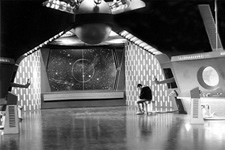
The long Czech cut also shows a fascinating detail that's barely explained. Some crewmembers sniff little tubes that look like Chapstik and are used as a sort of social icebreaker. Evidently the tubes contain pleasant smells (or more complicated "experiences"?) from back home. The only dialogue hint is in this exchange:
Woman, smiling as she smells: "Earth!"
At the party, three men swap tubes to sniff, as people might share a treat or use cigarettes.
The original Ikarie XB 1 is a much different experience than Voyage to the End of the Universe. American-International altered the story to make the spaceship an alien craft from an unknown planet. The American dub described the voyage as a one-way pioneering trip. Although we recognize the derelict space ship as being from Earth (the playing cards, numbers written on bulkheads) the voyagers theorize that it's a 'primitive craft' from some unnamed warlike civilization. In Voyage the destination of the space Odyssey is a "Green Planet," which turns out to be Earth. The friendly travelers from across the galaxy look out upon a view of the Statue of Liberty, a ratty-looking stock shot. American-International repeated this identical ploy in Mario Bava's 1965 Planet of the Vampires. Its "peaceful" aliens arrive in New York as bona fide invaders.
The Czech original may be twelve minutes longer. Both films start with an initially confusing sequence that shows Michael, crazed by the effects of the Dark Star, running amuck and threatening the ship. Crewmembers track Michael's position with a system of remote cameras that resemble metallic eyes. The Captain then remembers the launch from Earth, and the first seventy-five minutes of the show are a technical flashback until we catch up to the "Michael Amuck" scene again.
Added subplots flesh out the characters, which are much more individualized. The sunflower courtship that develops into a romance was dropped in the U.S. version, along with the entire story of the space pregnancy. The Science Officer is continually told to eat his 'vitamin food' and kidded about his antiquated robot, which he treats like an old friend.
The derelict space ship sequence is longer with a lot more dead card-playing capitalists and soldiers than are shown in the U.S. re-cut. We may assume that the ship is American, but when a spaceman examines a corpse's ID tag, the name we read sounds Eastern European. The film's most bizarre detail was cut out of the U.S. version entirely. We see the gas guns used to murder the crew; they are painted like toys and have English-language labels reading, "Tigger Fun." There is a whole rack of the instantaneous-acting nerve gas guns, like fire extinguishers, behind the Captain's chair -- "Tigger Fun" for the whole family! In a grisly image, one of the spacemen touches the dead Captain's face and the dry flesh drifts away from the skull as if it were underwater. The eerie ship interior is like a morgue, enhanced with funereal music, which becomes more pronounced as the spacemen run (in slow motion) to escape the nuclear blast. Many space movies have anti-nuke messages but this may be the most dramatic.
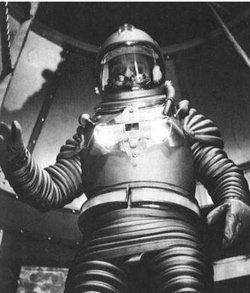
The order of the 'astronaut goes mad' and 'sleeping sickness' sequences may be reversed in the A.I.P. re-cut. The original Czech cut adds more detail to both episodes. When she can no longer stay awake, Bridget retreats alone to her cabin. As she slips into unconsciousness she records an audio last Testament, to be read by future Earth astronauts if they happen to find the Ikarie as another derelict wreck.
The birth of the baby becomes a hopeful event in the finale, which rises to a jubilant, spacey sense of wonder that resembles a collectivist rapture, as at the end of Steven Spielberg's Close Encounters of the Third Kind. The astronauts react individually and in groups to the glorious revelation of the White Planet, as Zdenek Liska's score reaches an emotional climax. There's even a heart tugging cut to the baby, who likewise seems to be staring in awe ... a classic bit of Kuleshov-Pudovkin cutting. The idiotic American version trims away most of the beatific faces, dulling the film's emotional impact.
Unlike some of the other Eastern-bloc space movies, Ikarie XB 1 doesn't have any direct political speeches. Very little of the dialogue is about conditions on Earth, and we don't know what kind of government is there. There is also no mention of organized religion, which some viewers may take as political commentary by omission. Unlike the inclusive worker's Utopia of Der Schweigende Stern there are no African or Asian astronauts, and the only names we hear are Bridget, Svensen, Mark, Stephanie, Ervin and Michael. Ikarie XB 1 is one of the best outer space movies ever, and surely the most serious made before Kubrick's film.
Filmexport Home Video's PAL Region 0 DVD of Ikarie XB 1 is an enhanced transfer of a fine B&W source in mostly good condition. Definition and contrast are very good. The image has some dirt here and there and a couple of instances of minor momentary unsteadiness. The final scenes have a fair dusting of dirt and speckles. The audio is bright and sharp; the menus offer a choice of removable subtitles in Czech or (thank goodness) English. The show probably has the 4% PAL speed-up, but Savant could only tell in a few scenes, as when The Engineer seems to walk a bit quickly. Zdenek Liska uses interesting electronic music for a main theme and more conventional instruments for emotional scenes.
The disc has a full extras menu: Bonusy. A featurette consists of film historian Pavel Taussig lecturing to camera for at least fifteen minutes. Other extras are illustrated with interesting stills, even if we cannot understand what is being said. Of immediate interest are clips from the beginning and ending of Voyage to the End of the Universe (pan-scanned), showing the Statue of Liberty and the ridiculous Anglicized credits: "Directed by Jack Pollack".
The numerous text extras are in Czech only, and more are available on DVD-ROM files. The helpful Marek looked at them and forwarded these (slightly rewritten) notes in English:
"... possibly the best extra on the disc is in the DVD-ROM section, a 1998 interview with director Jindrich Polák from the Czech SF magazine Ikarie, which happens to be named after the film. Polák talks about his 1961 visit to see Stanislaw Lem, as the film was inspired by one of the famous author's books. The director also went to the Russian rocket institute to get approval for his designs. Neither Lem nor the Russians were particularly interested in the project. Lem didn't like being asked stupid questions by nosey filmmakers, and with the Titov mission in progress the Russian scientists had other things on their mind. Their main concern was information leaks from their space program. Polák had to get space agency approval, and a "no" answer would probably have meant the end of his movie!
The director is asked where the "XB" in the title came from (Note: It reminds American Sci Fi fans of the early title Rocketship X-M). The name was Polák's idea. He wanted to combine Greek mythology with alphanumeric code to indicate that future Earthlings will be both cultivated and technologically advanced. In case it isn't self-evident, "Ikarie" is the Czech equivalent of "Icarus."
Other interviews are with Hynek Bocan, the assistant director; actor Radovan Lukavský; Zuzana Polaková, the director's wife; and Ondrej Neff, a Czech Sci Fi author and journalist. One of them fondly recalls the "dead capitalists scene", especially when the extras "equipped with fake eyes" joined the rest of the Studio Barrandov crew at lunch. Polák also talks about the film's reception at the Trieste Science Fiction Film festival in 1963.
The spaceship set was reused for Polák's children's film Clown Ferdinand and the Rocket (Klaun Ferdinand a Raketa). It was sold to 42 countries after winning the prize in Trieste."
Marek also reports that the A.I.P. beginning is hilarious from the Czech point of view because of the effort to make all the Czech filmmakers appear to be American. Some of the film's actors were and still are considered very big names on stage and in cinema in Czechoslovakia. He recommends another Science Fiction film by Jindrich Polák, a crazy time travel comedy called Zítra ráno vstanu a oparím se cajem (Tomorrow I'll Wake up and Scald Myself with Tea). It's "definitely not another Ikarie but is very funny indeed." 2
The disc comes packaged in a plastic bag with a printed brochure that includes a DVD cover that can be cut out. The cover art shows the Dark Star and a spaceship that looks more like the vacuum cleaner in Our Man in Havana. Other artwork, menus, etc. are handsomely designed.
As for buying the disc... I am told that a US web importer called Xploited Cinema carries the title. There is of course also the possibility that the film may come out in Region 1 at some future date. With its English track, and the inclusion of a little Union Jack on the cover, it looks as if this edition was intended to be marketed in the UK. 4
On a scale of Excellent, Good, Fair, and Poor,
Ikarie XB 1 rates:
Movie: Excellent
Video: Very Good (removable English subtitles)
Sound: Excellent
Supplements: Interviews, featurettes, text extras, catalog in Czech language only; A.I.P. version alternate titles and ending.
Packaging: Comes packed in card with printed material; DVD cover can be "cut out" of brochure
Reviewed: March 7, 2006
Footnotes:
1. The Time reviewer for Sword and the Dragon called its uncredited color photography "Color by Crayola," a phrase I've stolen several times.
Return
2. In 1965 Robert Lippert and Jack Parsons produced an obvious British knock-off of Ikarie XB 1 called Spaceflight IC-1. The short movie has a carbon-copy space voyage plot, with a terrible production and a hack script: The ship's captain must put down a feeble mutiny while trying to make one of the women passengers give up her unborn baby for medical reasons. It shows occasionally on the FX channel and is recommended only for curiosity's sake.
Return
3. This appears to be the problem with Wim Wenders' 4.5-hour, tryptich cut of Until the End of the World that he prepared around 1995. Warners distributed the original 2.6-hour short cut of the film and no agreement has been reached on the long cut. Wenders can't charge admission to screen it anywhere where Warners has distribution rights, which is why the only DVDs of the long cut (at present) are Region 2 PAL discs from Germany and Italy.
Return
4. Savant would like to publicly thank Marek for his extraordinarily generous offer. Savant keeps his "Czech DVD connection" info right next to his cell phone numbers for Steven Spielberg and Peter Jackson... without Marek's aid Ikarie would have been waaaay out of reach.
Return
A follow-up letter about European Sci Fi from Andreas Kortmann, 3.13.06:
Hey Glenn. Thanks for your (great) review of Ikarie XB I. I wouldn't rate the movie quite as high as you do but your review is informative and fun to read. I have noticed before that even though I disagree quite often with your evaluation of a movie it doesn't matter because after reading your reviews I always get a good idea about what to expect from a movie (if I haven't already seen it).
I have two minor corrections for your Ikarie XB I review: (note: corrections made) In a few weeks an extended version of Hard to Be a God, a Russian-German co-production, will be released over here, unfortunately only with a German language track and no subtitles. You know, I have quite a lot of German and East-European sci-fi movies and every time I watch one of them I am thinking, "Savant would love to see this...if it only had English subtitles." For example I'm just watching the German mini-series Raumpatrouille for the nth time. I grew up with this great space-opera. If you ever have the chance to see it (even without subtitles) you must do it. I'm sure you will love the look of it. I think some things were "borrowed" from Ikarie XB I.
Alas...so far the series is only available in German without subtitles. There is an English subtitled DVD of a recent theatrical edit (Raumpatrouille Orion -- Rücksturz ins Kino) but I heard and read that this version is terrible. Other favorites of mine are the Rainer Erler movies Operation Ganymed and Die Delegation and the five telemovies of Das Blaue Palais.
Well...I'm sure this is all mouth-watering for you and I'm really sorry that all this stuff is not available in subtitled form. Sometimes I even buy a DVD of a Russian or French movie without English or German subtitles but it's not that much fun to watch a movie if you only understand 5% of the dialog. However if you are desperate for a specific European sci-fi movie to an extent that you actually don't care if it's subtitled or not, tell me about it and I'll see what I can do. And if YOU ever get your hands on a decent digital copy of Zulawski's The Silver Globe...well, please send me a note. I haven't found one yet. -- Andreas
Review Staff | About DVD Talk | Newsletter Subscribe | Join DVD Talk Forum
Copyright © DVDTalk.com All rights reserved | Privacy Policy | Terms of Use
|
| Release List | Reviews | Price Search | Shop | SUBSCRIBE | Forum | DVD Giveaways | Blu-Ray/ HD DVD | Advertise |





